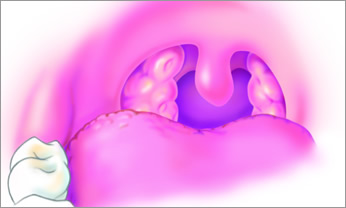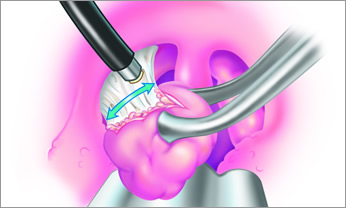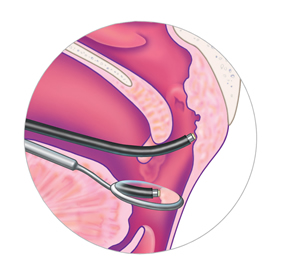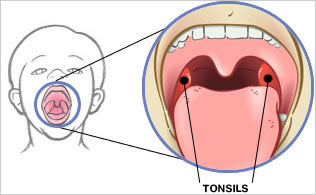
The tonsils and adenoid play an important role during childhood as a major defense system against infections in the upper respiratory tract. The tonsils are lymphoid tissues located in the back and on each side of the throat. The adenoid tonsil is also made up of lymphoid tissue and is located in the upper back part of the throat behind the nose. They work together to “catch” and trap incoming infections. Unfortunately, the tonsil and adenoid may become the source of infection itself like a plugged filter.
Each upper respiratory infection stimulates the tonsils and adenoid to enlarge to fight the next infection. Children now socialize at such a young age (daycare, preschool, etc), they develop more infections when the immune systems are still immature and their airways are still small. This all contributes to the increased incidence of tonsils and adenoid enlargement at younger ages relative to their throat size than in the past. Usually tonsils and adenoids only begin to gradually shrink in size after 12 years of age. By this age near complete facial and dental growth has occurred.
Tonsillectomy and adenoidectomy is the most commonly performed major surgical procedures in children. It is recommended for children with any of the following signs and symptoms:Adenoidectomy alone is often recommended for children with:
Numerous medical studies have definitively proven that removal of the tonsils and adenoids is helpful for the above problems without resulting in any negative impact on the immune system. Fortunately, there is ample other lymphoid tissue still remaining in the throat to perform its immune function (i.e., lingual tonsils on the back of the tongue, accessory tonsils on the back wall of the throat, Gerlach tonsils near the Eustachian tube opening, etc).
The throat heals very well after surgery because of its excellent blood supply. Unfortunately, this is the major reason that the most common major complication after tonsil and adenoid removal is hemorrhage, or excessive bleeding. This occurs in 3-4% of patients with tonsil and adenoid removal and less than 1% of patients with adenoidectomy alone. It most commonly occurs six to twelve days following surgery. It is extremely important to notify your doctor before surgery if your child or anyone in the family has a tendency to bleed or has hemophilia. This includes frequent nosebleeds, easy bruising, excessive bleeding with previous tonsil, dental or other surgery, abnormally heavy menstrual periods, prolonged bleeding after cuts or scrapes, and previous blood transfusions.
The following complications have been known to rarely occur:
Pre and Post Operative TonsilIectomy and or Adenoidectomy Instructions
Pediatric Sleep Airway Assessment
A tonsillectomy is a surgical procedure in which the tonsils are removed from the throat. An adenoidectomy is a similar procedure used to remove the adenoids. In many cases, the tonsils and adenoids are removed at the same time.
Coblation® tonsillectomy and adenoidectomy is a gentle procedure for removing both tonsils and adenoids offering a fast and easy recovery.
Traditional methods remove tonsils and adenoids by cutting or burning, which can cause extensive pain and damage to surrounding healthy tissue. Coblation is an advanced technology that combines gentle radiofrequency energy with a natural salt solution to quickly and safely remove tonsils and adenoids. Because traditional procedures use high levels of heat to remove the tonsils and adenoids, damage to surrounding healthy tissue is common. Coblation does not remove the tonsils or adenoids by heating or burning, leaving the healthy tissue surrounding the tonsils unaffected.


Coblation Tonsillectomy Brochure
 Coblation Adenoidectomy
Coblation AdenoidectomyCoblation can also be used to perform Adenoidectomy. The device used in this procedure is the EVac Xtra, EVac T&A Plasma Wand, or the PROcise EZ Plasma Wand. Coblation Adenoidectomy offers the following advantages:
The tonsils and adenoid play an important role during childhood as a major defense system against infections in the upper respiratory tract. The tonsils are lymphoid tissues located in the back and on each side of the throat. The adenoid tonsil is also made up of lymphoid tissue and is located in the upper back part of the throat behind the nose. They work together to “catch” and trap incoming infections. Unfortunately, the tonsil and adenoid may become the source of infection itself like a plugged filter.
Each upper respiratory infection stimulates the tonsils and adenoid to enlarge to fight the next infection. Children now socialize at such a young age (daycare, preschool, etc), they develop more infections when the immune systems are still immature and their airways are still small. This all contributes to the increased incidence of tonsils and adenoid enlargement at younger ages relative to their throat size than in the past. Usually tonsils and adenoids only begin to gradually shrink in size after 12 years of age. By this age near complete facial and dental growth has occurred.
Tonsils
The adenoids are a clump of lymphoid tissue similar to that of tonsils, but located higher up in the throat, behind the nose. Adenoids also help the body fight infections by trapping and fighting germs as they pass through the breathing passage.
Adenoids
The adenoids are a clump of lymphoid tissue similar to that of tonsils, but located higher up in the throat, behind the nose. Adenoids also help the body fight infections by trapping and fighting germs as they pass through the breathing passage.

